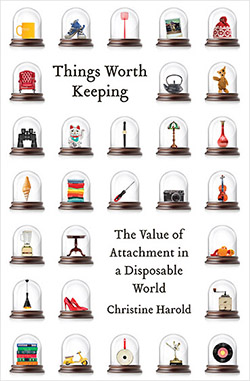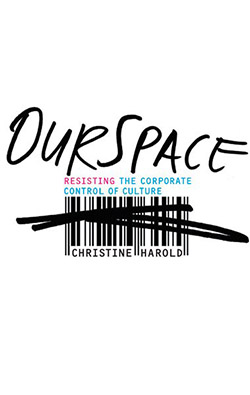Things Worth Keeping
A timely examination of the attachments we form to objects and how they might be used to reduce waste.
Rampant consumerism has inundated our planet with pollution and waste. Yet attempts to create environmentally friendly forms of consumption are often co-opted by corporations looking to sell us more stuff. In Things Worth Keeping, Christine Harold investigates the attachments we form to the objects we buy, keep, and discard, and explores how these attachments might be marshaled to create less wasteful practices and balance our consumerist and ecological impulses.
For too long, the contemporary individual’s relationship with ordinary things has been prematurely chastised as commodity fetishism or blindly embraced as conspicuous consumption. Christine Harold offers a welcome alternative, in which objects are cast in complex, subtle roles amid a broader human drama.
–Ian Bogost, author of How to Talk about Videogames
With thrift stores overflowing with ‘fast fashion,’ China hitting its limit for outsourced recycling, and even decluttering queens suddenly hawking crystals, it’s clear that Westerners buy too much shit. But permit yourself one more acquisition: Christine Harold’s beautiful new book, which explores how practices ranging from hacking and crafting to artisanship and storytelling can help us forge more sustained and, thus, sustainable relationships with the objects in our lives.
–Nicole Seymour, author of Bad Environmentalism: Irony and Irreverence in the Ecological Age
Given what we are living through, I imagine my students will have plenty to say about Harold’s arguments. She will be a marvelous companion for us as we confront the changing face of capitalism and ask what things are worth keeping in this era of economic and political turmoil.
–Heidi Aronson Kolk, Material Culture
Things Worth Keeping pushes audiences to be shaped by their emotional reactions to the environmental impact of their consumption…Incidentally, the things I bought, the things I used, and the things I threw away while reading Things Worth Keeping became inexorably intertwined with how I thought about the attachments–big and small–to various other things around me.
–Lydia Pyne, author of Genuine Fakes: How Phony Things Teach Us About Real Stuff
Harold explores a rarely analyzed subject in an absorbing manner. The health of the environment is dependent on humans figuring out a way to produce and discard less stuff, and Harold can help us begin to understand how to make that possible.
—Rebecca Kluberdanz, Library Journal
What to get and how to get it, how to take care of stuff, and what to get rid of and how–these are vexing everyday matters, with vast if often unseen consequences. Christine Harold’s Things Worth Keeping takes up these issues by analyzing big box stores and offbeat brands, mainstream trends and rogue artworks, political economic theory and journalistic hot takes.
—Christopher Schaberg, ISLE
[Things Worth Keeping] raises intriguing questions about how new materialism’s interest in things might be used to oppose the increasingly toxic consumer waste highlighted by environmentalists and it does so through multiple openings, offering possibilities for many kinds of consumers.
—Catherine Chaput, The Quarterly Journal of Speech
It is easy to find either dark green screeds against capitalism’s iniquities or mildly reformist injunctions towards green consumerism, so I found this book attractive in its willingness to recognise consumerism’s seductiveness as well as its real evils, and its implicit attempt to turn the system’s own strengths back upon itself.
—Piers H.G. Stephens, Environmental Values
OurSpace
In OurSpace, Christine Harold examines the deployment and limitations of “culture jamming” by activists. For Harold, it is a different type of opposition that offers a genuine alternative to corporate consumerism. Exploring the revolutionary Creative Commons movement, copyleft, and open source technology, Harold advocates a more inclusive approach to intellectual property that invites innovation and wider participation in the creative process.
This book deftly navigates the borders between markets and publics. And it offers us strategies of survival in and resistance to the increasingly corporatized digital realm.”
–Siva Vaidhyanathan, author of Antisocial Media: How Facebook Disconnects Us and Undermines Democracy
As a writer Harold is clear and witty, and her accessible style should combine with the popular attention to the cultural issues she addresses to earn this book a strong reception from cultural studies students as well as activists and concerned citizens in general.
–Danny Kimball, The Velvet Light Trap
A follow-up to the bible of brand resistance, Naomi Klein’s No Logo, Harold’s book is an academic survey of and intense meditation on the efficacy of current culture jams. She explores the limitations of sabotage, the role of parody and models of success. Adbusters, Barbie Liberation Organization, Yes Men are all placed under her scrutiny. I was familiar with all of the above, but OurSpace led me also into new territory.
— Jim Poyser, NUVO
The most comprehensive scholarly account of culture jamming to date.
–Marilyn DeLaure and Moritz Fink, eds., Culture Jamming: Activism and the Art of Cultural Resistance
The commercialization of public life, civic culture, and even child-rearing has become a major focus for radical critique as freedom seems to narrow to life-style choices. Christine Harold critiques the strategies of resistance developed so far, whether they be those seeking state intervention or anarchist-style pranking and pirating appropriation of the tools of the manipulators of mass cultures.
– Tikkun
Harold presents a sophisticated rhetorical analysis of countercultural communication. Offering many interesting, entertaining examples, she explores and evaluates the strategies and tactics these communicators use to subvert the dominant commercial and political voices and reach audiences. Highly recommended.
– Choice
From guerilla protesters who throw pies in the faces of prominent figures in the international sociopolitical community to people who create gender reassignment by switching the voice boxes in talking G.I. Joe and Barbie dolls, Harold provides a good overview of the world today and what citizens are doing to create a space free of corporate control.
– Conscious Choice
For anyone interested in the Creative Commons movement, the history of culture jamming, or civic politics and the creation and definition of publics, OurSpace is a must.
– Steel Bananas

